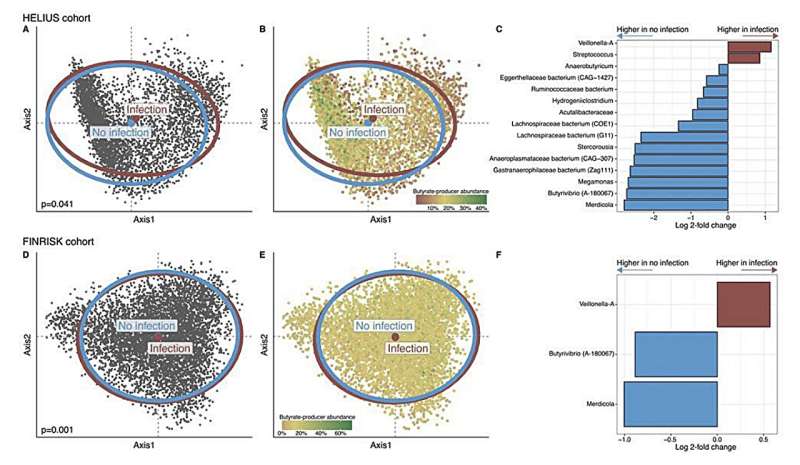This article has been reviewed according to Science X's editorial process and policies. Editors have highlighted the following attributes while ensuring the content's credibility:
fact-checked
proofread
Study: For each 10% increase of bacteria type in the gut, risk of hospitalization for infection falls by up to a quarter

A study of two large European patient cohorts has found that for every 10% increase in butyrate-producing bacteria in a patient's gut, the risk of hospitalization for any infection falls by between 14 and 25% across two large national cohorts. The study will be presented at this year's European Congress of Clinical Microbiology and Infectious Diseases (ECCMID 2024) in Barcelona, Spain (27–30 April).
Microbiota alterations are common in patients hospitalized for severe infections and preclinical models have shown that anaerobic butyrate-producing gut bacteria protect against systemic infections. These bacteria were investigated because they are commonly depleted in patients hospitalized for severe infections. Secondly, butyrate may have protective effects in several intestinal diseases (other than infections).
The relationship between microbiota disruptions and increased susceptibility to severe infections in humans remains unclear. In this study, the authors investigated the relationship between baseline gut microbiota and the risk of future infection-related hospitalization in two large population-based cohorts—from the Netherlands (derivation; HELIUS) and Finland (validation; FINRISK 2002).
Gut microbiota were characterized by sequencing the DNA of bacteria to identify the different types of bacteria present in fecal samples of the participants. The authors measured microbiota composition, diversity, and relative abundance of butyrate-producing bacteria.
The primary outcome was hospitalization or mortality due to any infectious disease during five- to seven-year follow-up after fecal sample collection, based on national registry data. The authors then examined associations between microbiota and infection risk using computer modeling. Further statistical modeling was used to adjust for variables including demographics, lifestyle, antibiotic exposure, and comorbidities.
The researchers, led by Robert Kullberg, Amsterdam University Medical Center, The Netherlands, profiled gut microbiota from 10,699 participants (4,248 from The Netherlands and 6,451 from Finland. A total of 602 participants (The Netherlands: n=152; Finland: n=450) were hospitalized or died due to infections (mainly community-acquired pneumonia) during follow-up.
Gut microbiota composition of these hospitalized/deceased participants differed from those without hospitalization for infections. Specifically, each 10% higher abundance of butyrate-producing bacteria was associated with a reduced risk of hospitalization for infections—25% lower for participants from the Dutch cohort and 14% lower for the Finnish cohort. All types of infections were assessed together, not any one in particular. These associations remained unchanged following adjustment for demographics, lifestyle, antibiotic exposure, and comorbidities.
The authors say, "Gut microbiome composition, specifically colonization with butyrate-producing bacteria, is associated with protection against hospitalization for infectious diseases in the general population across two independent European cohorts. Further studies should investigate whether modulation of the microbiome can reduce the risk of severe infections."
The authors say further analysis will be needed before trails in patients can begin. One of the challenges is the face are the butyrate-producing bacteria are strictly anaerobic (meaning they respire without using oxygen and cannot tolerate oxygen), which makes it very difficult to transport viable bacteria into the gut. Several research groups are working on addressing these challenges.
More information: Impact of butyrate-producing gut microbiota on the risk of infectious disease hospitalisation: results from two large population-based cohorts




















